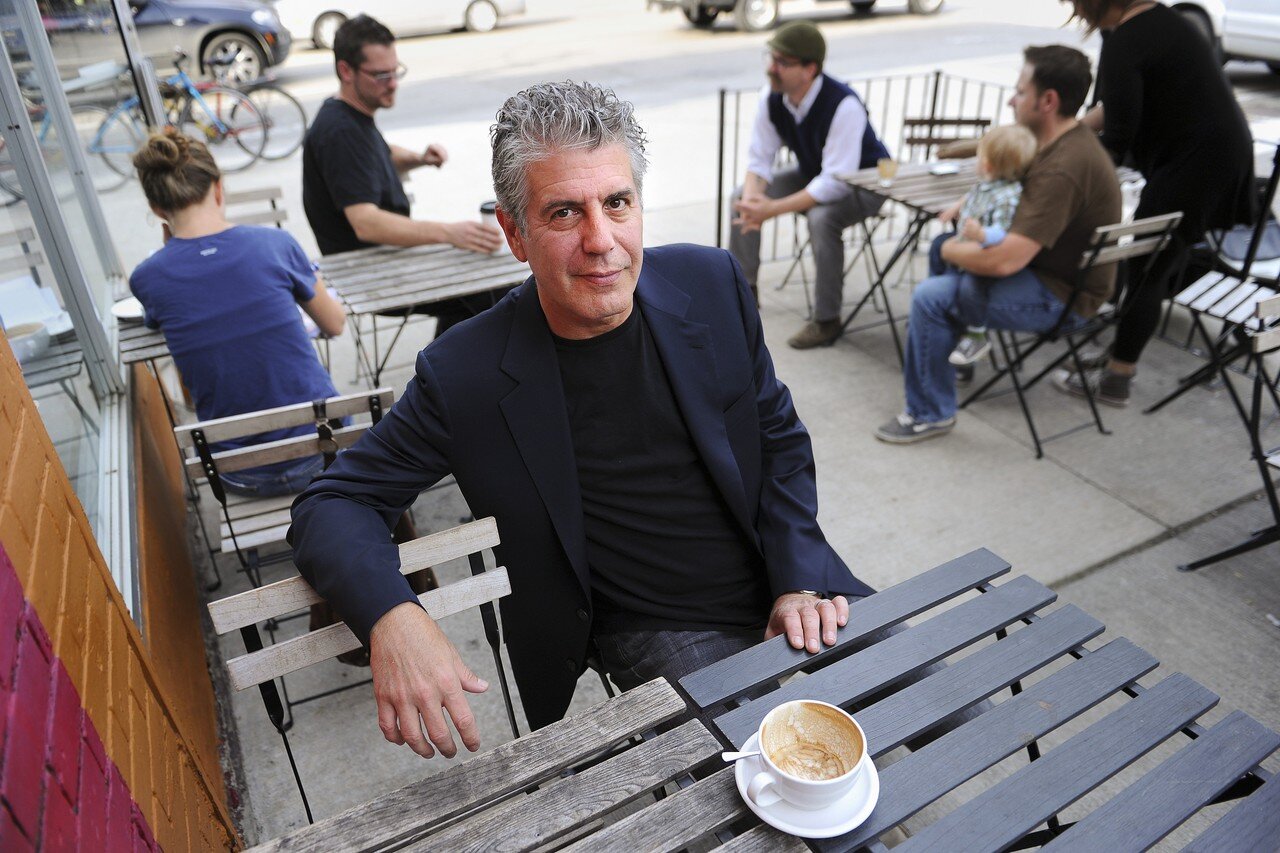World Travel: An Irreverent Guide
ANTHONY BOURDAIN. Who amongst food lovers, world travellers, and culture mavens does not know him, respect him, and wish he were still around? He was a singular voice in food writing, but he was more. Every essay he wrote or TV series he produced was not only an invitation to experience something authentic, but also a come-on to learn something new about the people, the place, and its history. The subtitle is spot-on. He was irreverent and we, his followers, loved him that way. Effusive with praise if he liked the meal (or the people); but otherwise, blunt, rude, and sometimes, profane. He was a rogue, a lovable one, and God, how we miss him!
It has been three years since he took his own life, so the book is a posthumous collection of his favorite places and the food he enjoyed there. It was lovingly put together by his “lieutenant”, Laurie Woolever, assistant on his TV series, fellow food writer, and editor. She tells us in the introduction that Bourdain first spoke about a book like this in 2017. They had an hour-long conversation about which countries and stories could be included. Too short for a big project, but, well, fate took over. If anyone knew Bourdain’s thoughts, style, and preferences, however, it would be Woolever. The tone of World Travel was set by Bourdain. She made it very clear.
“It was never my intention to be a reporter, a critic, an advocate. It was also never my intention to provide audiences with ‘everything’ they needed to know about a place—or even a balanced or comprehensive overview. I am a storyteller. I go places, I come back. I tell you how the places made me feel. Through the use of powerful tools like great photography, skillful editing, sound mixing, color correction, music (which is often composed specifically for the purpose) and brilliant producers, I can—in the very best cases—make you feel a little bit like I did at the time.”
Photo: David S. Holloway/Courtesy of CNN
43 countries were covered in this book, from Argentina to Vietnam, traversing parts of North and South America, Europe, Africa, and Asia. They are alphabetically presented. Each country has a list of hotels and restaurants to go to, the food to eat, and a little bit of history of the food and the country. Like Lonely Planet or Frommer guides, it also contains information about airports, taxis and trains. It is by no means comprehensive; you’d still need other guidebooks, maps, and travel agents. What you have, however, are Bourdain’s eyes, which saw things we didn’t know were even there; and his voice, that irrepressible selling voice that makes you feel, “I’ve got to have that meal!” or “I have to see that place!” because Bourdain enthused about them.
Woolever superimposed his eyes and voice by selectively culling the most interesting insights and quotes from his books (e.g. Kitchen Confidential, A Cook’s Tour, No Reservations) and his CNN documentaries (e.g. Layover and Parts Unknown). When Bourdain “spoke”, Woolever used bold, blue fonts. Inimitably him. We avidly followed his TV series and we recognized some of the quotes as his voice overs, and they’re all right. We wished, however, that she also included the times when he was asking tough questions or messed around with his travel companions and the locals. The mischief was pure Bourdain. He sought out the nooks and crannies of the world and never flinched from touching something new, strange, even dangerous. He made us wish we travelled like he did.
Here’s a menu of Bourdain observations and quotes. He called Osaka “the city of excess” and Japan’s “national kitchen.” There’s a tapas bar in Barcelona, Quimet & Quimet, about which he said, “If I lived across the street from this place, I’d quit my job and just hang out here all day, until all the money was gone.” Asked which is the greatest food city, he replied, “I always say that no one can say you’re wrong if you say Hong Kong.” He felt living in New York was like being in the center of world – until he visited Shanghai, where he had a taste of xiao long bao, the world’s most perfect food in his mind. While in Melbourne, he praised a spicy Sichuan meal, calling it “the flavor equivalent of a weekend at Caligula’s House.” He lavished praised on New York City’s Barney Greengrass Restaurant: “If God made anything better, he kept it for himself.”
Bourdain made many restaurants famous, for good or bad. A little hole in the wall became an overnight sensation because he featured it in his show. A former restaurant owner in Toronto, Jenny Agg, describes this tremendous surge of interest the “Bourdain Effect”. She even has a personal term for it: “getting Tony’d”.
Photo: William Mebane for The New Yorker
He did have sober moments, even angry ones, like when he visited Cambodia and reflected on the genocide unleashed by Pol Pot. He knew the tyrant wasn’t the only one to blame: “Once you’ve been to Cambodia, you’ll never stop wanting to beat Henry Kissinger to death with your bare hands.” He said, “Sardinia’s the kind of place you better know somebody.” About Jerusalem, he wrote: “First, look around. It’s like everybody says, ‘It’s pretty. It’s awesome. It’s urban, sophisticated, hip, like Southern California, only nicer.’ Then you see the young draftees on the streets and you start to get the idea.” He was brash and didn’t always follow rules. He was banned in Azerbaijan, for traveling to the Nagorno-Karabakh region.
Photo: Richard Lautens, The Toronto Star
Woolever also sought fresher takes from friends and associates to supplement World Travel. We found the essays of Bourdain’s brother, Chris, sentimental but effective as he reminisced about their trips to France (“where it all started”), New Jersey, and Uruguay. In the last country, they tried to find a relative, or so they said. It seemed more like an excuse to roam around, find the best food, and drink to their hearts’ content. The essay written by Nari Kye, a director in Bourdain’s CNN TV series, was touching. Kye is ethnically Korean, but tried to deny it. Bourdain brought her to Seoul, interviewed her family, and used her as his guide and tutor. Kye came to terms with her roots; the trip changed her life. She is now an advocate for Korea.
We would be remiss if we didn’t mention two countries that Bourdain grew fond of: the Philippines and Singapore. Full disclosure: we’re Filipinos and we’ve lived in Singapore. It’s therefore quite refreshing that Bourdain visited Manila twice: the first in 2008; he returned in 2015. He loved our sisig, saying, “For me, the ‘come to mama’ moment is that most loved of Filipino street foods, the strangely addictive, sizzling hot mélange of hacked up pork face. A crispy, chewy, spicy, savoury, and altogether damn wonderful mélange of textures that just sings.”
Courtesy of CNN
And one other thing: “That I sneer at fast food – revile it at every opportunity – but I am also a hypocrite because to me, the Filipino chain Jollibee is the wackiest, jolliest place on earth. There are over 900 of these things (many more now), all over the 7,000 plus Philippine islands, and a whole lot more, internationally, wherever there are homesick Filipinos.”
With Laurie Woolever. Photo: GPB.org
What about Singapore? He observed that “New York may be the city that never sleeps, but Singapore’s the city that never stops eating.” Right! He added: “Singapore’s probably the best place you can go for a maximum bang in a minimum period of time.” He praised the variety, options, and specialties of China, Malay, and India. He loved the Tiong Bahru Hawker Center and craved laksa, chicken rice, teck seng soya bean milk, kampong carrot cake, chwee kueh, char kway teow, and nasi lemak. He enjoyed Singapore, impressed that it is “spotless, efficient, safe, protected, a utopian city-state run like a multinational company.” The rebel knew that in Singapore it’s best to obey the rules.
“Welcome to my world”, Bourdain said when he opened his TV series, “A Cook’s Tour.” World Travel is the closest thing to a welcome a reader could have now that he’s gone. The timing of its release is most opportune. With Covid-19 still around and travel not open yet, it might not be a bad idea to hunker down and dig into whichever country (or countries) you may be thinking of visiting when conditions are finally favourable. Or reminisce a trip you once had and see if you agree with his assessment – or if you missed something. The only other alternative is to watch the replays of his TV show. Either way, you get to feel again a most unique perspective and brand of irreverence. At best, you’ll see things with a new set of eyes. It will be like seeing them for the first time.
Jojo Fresnedi & Rhodora Palomar-Fresnedi | ws guest contributors






